 The movies of the 1890s tended to be less than a minute long, many having been made for mutoscopes or flip-card peepshow machines, the earliest of which only ran for twenty seconds.
The movies of the 1890s tended to be less than a minute long, many having been made for mutoscopes or flip-card peepshow machines, the earliest of which only ran for twenty seconds.
Some of these films have intrinsic interest but even the least of them are intriguing for showing how swiftly filmmakers were mastering techniques of a new technology, & for providing windows in the sorts of things that entertained folks of the Romantic '90s, or for capturing real moments of the past like tiny time machines.
A Hand-Shake (1892) consists of a handshake between Dickson & his cameraman William Heise, congratulating one another on the successes inventing the kinetograph. Clearly they understood that their work was one that could preserve historic occasions.
Once you've seen enough of them the mind adjusts to the ultra-shortness of each film, & begins to detect some real cinematic gems that do far more with the short-short format than might be expeccted, while others may seem like production line piffles.
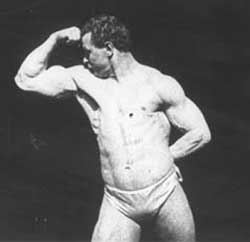 A truly formative pioneer was William K. L. Dickson whose first experiments were playful & minor, but marvelous when one realizes he invented the equipment (even though Thomas Edison patented everything in his own name) & each of his earliest early films brought him closer to getting a whole new entertainment industry up & running.
A truly formative pioneer was William K. L. Dickson whose first experiments were playful & minor, but marvelous when one realizes he invented the equipment (even though Thomas Edison patented everything in his own name) & each of his earliest early films brought him closer to getting a whole new entertainment industry up & running.
The "wand" in Athlete with Wand (1894) is a four foot wooden pole with which he does an exercise routine. It looks for all the world like he's a jujitsu or karate expert using a bo staff in a series of kata for blocking an attack.
Although the content & length of Athlete with Wand are minimalist, Dickson was guessing right that sports & physical culture were going to be important to the new industry's commercial viability.
One of the leading figures in Physical Culture of the time is featured in Sandow No. 1 variously known as Souvenir Strip of the Edison Kinetoscope, Sandow: The Strong Man or Sandow, the Modern Hercules (1894).
Born Freidrich Muller, Eugen Sandow became world-famed by the time of the Chicago Columbian World Exposition, later a big star at Koster & Bial's Music Hall in New York, & the first really big star promoted by Florenz Ziegfeld at the very start of Ziegfeld's stellar career.
Sandow was such a media darling of the age that when he agreed to make a film of his muscle act at Edison's Black Maria Studio, it was all over the news.
It was one of the first big commercial successes for kinetoscopic films, of mutual benefit since Sandow helped get the filmmakers the attention they wanted, & the film helped turn Sandows book on physical training a runaway bestseller.
Negatives had a limited life expectancy & when they were too worn out to strike more copies to sell to exhibitors, they had to be refilmed from scratch. A second version of Sandow (1896) was made two years later to meet continued demand, the photographer unidentified.
Another unknown photographer at the Edison company revisited their popular beefcake star a few years later in Eugen Sandow: The World's Strongest Man (1903) wherein he did pretty much the same routine but with tight boots in addition to his undies, & a backflip at the end.
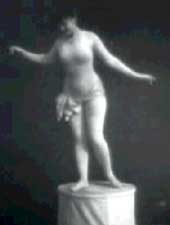 Treloar & Miss Marshall, Prize Winners at the Physical Culture Show in Madison Square Garden (1904), by an unknown photrapher, preserves a good record of two more physical culture icons of the age. Treloar & Miss Marshall, Prize Winners at the Physical Culture Show in Madison Square Garden (1904), by an unknown photrapher, preserves a good record of two more physical culture icons of the age.
Beatrice Marshall & Al Treloar nee Jennings were judged the most perfect specimens of man & woman at the bodybuilding exhibition. Two weeks later in the Black Maria studio, their posing routines were committed to film.
Beatrice is wearing body sock & a bunch of grapes (symbolic of the Greek maenads) hanging in front of her crotch.
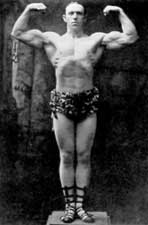 She stands on a pedestal taking classical statuary poses & she's a babe & a half, very shapely & healthy with a substantial ass. And face it, nice ass was the reason people watched these things, not good health or eagerness personally to exercise. She stands on a pedestal taking classical statuary poses & she's a babe & a half, very shapely & healthy with a substantial ass. And face it, nice ass was the reason people watched these things, not good health or eagerness personally to exercise.
Albert is a nice piece of beefcake, too, taking a few Greek statue poses then doing the typical muscle-man flexing poses, wearing a leopard skin loincloth evocative of a jungle feral man.
This jungle dude referencing came about in physical culture philosophy of human primitive greatness spoilt by too much civilization.
And this really is where Tarzan derives, Edgar Rice Burroughs being throughly grounded in the eugenic & physical culture belief.
ERB's initial intent was to show that a white man if removed in infancy from civilization, even if raised by apes, his good breeding would cause him to rise to the occasion & he would excel in the wild environment. Sad to say, the philosophy also assumed that non-white aboriginal peoples were uncivilized due to natural inferiority.
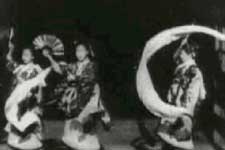 The team of Dickson & Heise also lit on dance as a salable subject for early moton pictures, as what could be more intriguing than dance in this new context of pictures that moved without sound. Dance movement not only implied sound for the imagination, it made maximum use of the human body in motion.
The team of Dickson & Heise also lit on dance as a salable subject for early moton pictures, as what could be more intriguing than dance in this new context of pictures that moved without sound. Dance movement not only implied sound for the imagination, it made maximum use of the human body in motion.
Titled so as to promise exotica from far lands, Imperial Japanese Dance (1894) actually stars the Sarashe Sisters in Japanese kimonos. They are doing a cloth-twirling choreography distinctly not Japanese in origin, but was typical of American dances of the era as performed at fairs, exhibitions, & in vaudeville.
The Sarashes gave a tasteful performance. Given the peep-show qualities inherent to mutoscope & kinetoscope entertainment, not all the "dance" films of the era were so much about dancing as they were about sex-teases, posing as dance films to be legal. Imperial Japanese Dance is a real dance film.
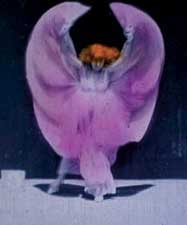 Annabelle Serpentine Dances (1894) with 50 feet of film, & two versions of Annabelle Butterfly Dances (1894) with 50 feet & 25 feet of footage respectively, were by Dickson & Heise. William Heise without Dickson's input made another 52 foot version of Annabelle Serpent Dances (1895). Annabelle Serpentine Dances (1894) with 50 feet of film, & two versions of Annabelle Butterfly Dances (1894) with 50 feet & 25 feet of footage respectively, were by Dickson & Heise. William Heise without Dickson's input made another 52 foot version of Annabelle Serpent Dances (1895).
The reason she was filmed so often at Edison was because her film footage was extremely popular & negatives wore out from making so many copies. They were often hand-tinted, & this work was done by wives of Edison employees, for customers willing to pay for the extra touch. The purple-tinted screen-capture is from Heise's rather sweepingly beautiful 1895 Annabelle Serpentine Dances.
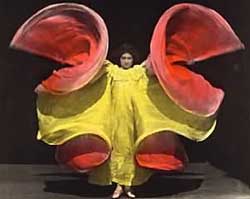 Very similar to Annabelle's performances & a later performance by Amita (1903) is that of barefoot Crissie Sheridan (1897), photographer unknown but very likely Heise. Very similar to Annabelle's performances & a later performance by Amita (1903) is that of barefoot Crissie Sheridan (1897), photographer unknown but very likely Heise.
Crissie did her "skirt dance" whirling about in a veritable cloud of fabric. The dancer's voluminous dress, plus two-foot rods to extend her the reach of her costume's sweep, creates the butterfly & double-coils images of cloth. This was another one often hand-colored by wives of Edison employees.
F. S. Armitage directed Amita, a rather amazing dancer who creates enormous flowing whirling butterfly wings of fabric held on flexible poles.
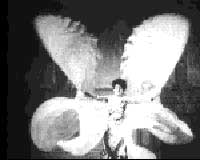 We've seen that a lot kinescopic "dance" films are really seedy burlesques barely posturing as dance, but Amita, though cleary not a young woman, is magnificant, creating veritable spirals of flowing cloth surrounding her graceful form, & ending with a cyclonic whirl of self & fabric. We've seen that a lot kinescopic "dance" films are really seedy burlesques barely posturing as dance, but Amita, though cleary not a young woman, is magnificant, creating veritable spirals of flowing cloth surrounding her graceful form, & ending with a cyclonic whirl of self & fabric.
She was nevertheless a vaudeville performer who created several dances that sound spectacular though the others were never captured on film. Newspapers of the day describe her dancing through prismatic sets, fiery sets (probably fabric faking fire), & water fountain sets (with real water). And she was most famous for a "mirror dance" amidst eight enormous plate-glass mirrors.
Too bad a multi-chapter feature wasn't filmed of all her creations! As it is we'll have to settle for a half-minute of amazement, a gal on the vaudeville circuit who really raised the bar of talent. Both Amita & Chrissie Sheridan essentially show no skin & demand to be appreciated for their art rather than as burlesque queens. With such as these we find one of the roots of modern jazz dance.
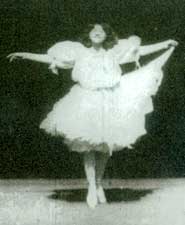 William Heise also made Amy Muller (1896) featuring a vaudeville dancer. This one, too, was frequently hand-tinted.
William Heise also made Amy Muller (1896) featuring a vaudeville dancer. This one, too, was frequently hand-tinted.
Billed as a "toe dancer," there are elements of ballet to her performance, though in burlesque theaters this is just an excuse to wear ballerina dresses & show the mainly male audiences a lot of leg.
As a "dancer" Amy's best move is hopping up & down on one leg, the other leg held above her head. She can also do a childlike cartwheel a mite awkwardly. Her concluding twirl is the "big close" revealing the full length of leg as the dress rises up.
Films of unskilled dancers only make sense after a modern viewer realizes this was what passed for a girlie show in theaters that didn't want to get raided. Even by just teasing the bald guys in the front row with little more than frilly dresses lifted up to show heavy panties, they weren't guaranteed no trouble from the police.
For kinetoscope & mutoscope use these films were the original peepshows. They could claim a non-purient level of interest, dancing being pure motion, & moving pictures being still very new & surprising without further content. But if they hadn't been pitched to the libido, the Edison company would've been relying on serioius ballet troupes & not vaudeville for their dance stars.
Yet I find it difficult to believe the primary prurient crowd needed such films colorized. Any arcade that did manage to pull in more of a family crowd might delight wives & kids with a dancer in full color, for which reason even the cheezier dance films were frequently hand-colored, including Amy Muller.
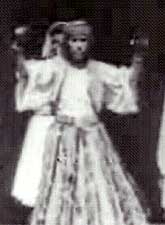 When the Barnum & Bailey circus was in Orange, New York, the home of Edison's Black Maria film studio, some of the acts came over to the studio to put themselves into the motion picture record. Of that group of films, only Heise's Princess Ali: Egyptian Dance (1895) survives. When the Barnum & Bailey circus was in Orange, New York, the home of Edison's Black Maria film studio, some of the acts came over to the studio to put themselves into the motion picture record. Of that group of films, only Heise's Princess Ali: Egyptian Dance (1895) survives.
Princess Ali performs her "danse du ventre" to her troupe's flute & drum accompaniment. We're probably safe assuming she was not an Egyptian princess, & really she's not even much of a dancer.
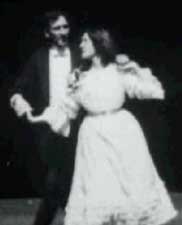 In voluminous gypsy dress, she prances back & forth in front of her troupe waving two scarves like they were flags. The historical significance is this is a precursor to the modern bellydance, the term "belly dancer" having not yet been coined. In voluminous gypsy dress, she prances back & forth in front of her troupe waving two scarves like they were flags. The historical significance is this is a precursor to the modern bellydance, the term "belly dancer" having not yet been coined.
One more Heise dance film can be mentioned, a rather crude yet offbeat one since it lacks either the glamor or sexiness of the circus or vaudeville. Charity Ball (1897) is a rather dull, though perhaps these dancers were the Fred & Ginger of their day & more exciting in their time.
The film is a quick chronicle of exhibiton dance steps of the day. Modern fans of ballroom dancing would probably like this for its historical value.
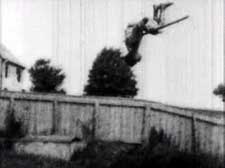 Juan Caicedo was a Venezuelan highwire performer who was at Koster & Bial's Music Hall the year he was asked by Dickson to be filmed for Caicedo with Pole (1894).
Juan Caicedo was a Venezuelan highwire performer who was at Koster & Bial's Music Hall the year he was asked by Dickson to be filmed for Caicedo with Pole (1894).
The nature of his act meant Dickson & his cameraman William Heise couldn't do it in the Black Maria studio, but had to take their equipment outdoors.
Caicedo's "slack wire" performance is quite extraordinary. He doesn't merely walk across a rope with a balancing beam in hand, but gets the rope bouncing like mad so that he seems to be on a trampoline, doing backflips.
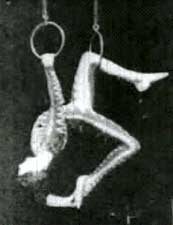 Luis Martinetti or Louis Martinetti, Contortionist(1894) was a trapeze performer, one of the three Martinetti Brothers. Luis was touring on his own at this time. Luis Martinetti or Louis Martinetti, Contortionist(1894) was a trapeze performer, one of the three Martinetti Brothers. Luis was touring on his own at this time.
Like Caicedo he at his physical art. A pair of trapeze rings were hung up in the Black Maria studio & we see Luis in tiger-stripe tights putting himself into contorted positions with legs & arms through the rings.
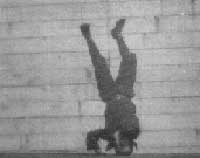 Acrobats weren't just found in the theaters. A Street Arab (1898) is by an unknown photographer. Acrobats weren't just found in the theaters. A Street Arab (1898) is by an unknown photographer.
It features a nameless street performer. The fellow doesn't look more than about thirteen, & possibly a lot younger.
He stands on his head & does a few simple acrobatic moves. It is a half-minute of nothin' much, but is intriguing as an authentic street urchin's begging act. He's filmed against a wooden wall apparently out in the street where just such kids performed for pennies or nickels.
copyright © by Paghat the Ratgirl
|
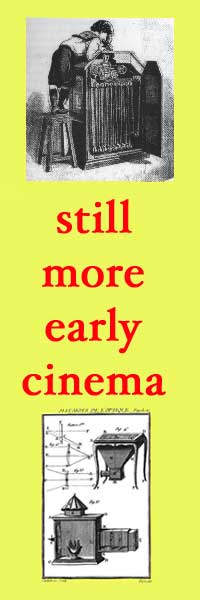


 Treloar & Miss Marshall, Prize Winners at the Physical Culture Show in Madison Square Garden (1904), by an unknown photrapher, preserves a good record of two more physical culture icons of the age.
Treloar & Miss Marshall, Prize Winners at the Physical Culture Show in Madison Square Garden (1904), by an unknown photrapher, preserves a good record of two more physical culture icons of the age. She stands on a pedestal taking classical statuary poses & she's a babe & a half, very shapely & healthy with a substantial ass. And face it, nice ass was the reason people watched these things, not good health or eagerness personally to exercise.
She stands on a pedestal taking classical statuary poses & she's a babe & a half, very shapely & healthy with a substantial ass. And face it, nice ass was the reason people watched these things, not good health or eagerness personally to exercise.

 Very similar to Annabelle's performances & a later performance by Amita (1903) is that of barefoot Crissie Sheridan (1897), photographer unknown but very likely Heise.
Very similar to Annabelle's performances & a later performance by Amita (1903) is that of barefoot Crissie Sheridan (1897), photographer unknown but very likely Heise. We've seen that a lot kinescopic "dance" films are really seedy burlesques barely posturing as dance, but Amita, though cleary not a young woman, is magnificant, creating veritable spirals of flowing cloth surrounding her graceful form, & ending with a cyclonic whirl of self & fabric.
We've seen that a lot kinescopic "dance" films are really seedy burlesques barely posturing as dance, but Amita, though cleary not a young woman, is magnificant, creating veritable spirals of flowing cloth surrounding her graceful form, & ending with a cyclonic whirl of self & fabric.
 When the Barnum & Bailey circus was in Orange, New York, the home of Edison's Black Maria film studio, some of the acts came over to the studio to put themselves into the motion picture record. Of that group of films, only Heise's Princess Ali: Egyptian Dance (1895) survives.
When the Barnum & Bailey circus was in Orange, New York, the home of Edison's Black Maria film studio, some of the acts came over to the studio to put themselves into the motion picture record. Of that group of films, only Heise's Princess Ali: Egyptian Dance (1895) survives. In voluminous gypsy dress, she prances back & forth in front of her troupe waving two scarves like they were flags. The historical significance is this is a precursor to the modern bellydance, the term "belly dancer" having not yet been coined.
In voluminous gypsy dress, she prances back & forth in front of her troupe waving two scarves like they were flags. The historical significance is this is a precursor to the modern bellydance, the term "belly dancer" having not yet been coined.
 Luis Martinetti or Louis Martinetti, Contortionist(1894) was a trapeze performer, one of the three Martinetti Brothers. Luis was touring on his own at this time.
Luis Martinetti or Louis Martinetti, Contortionist(1894) was a trapeze performer, one of the three Martinetti Brothers. Luis was touring on his own at this time. Acrobats weren't just found in the theaters. A Street Arab (1898) is by an unknown photographer.
Acrobats weren't just found in the theaters. A Street Arab (1898) is by an unknown photographer.